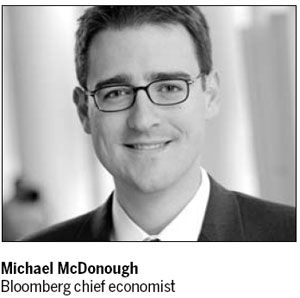Is the 'rebalancing' really taking off?
Updated: 2013-11-26 07:31
By Zheng Yangpeng (China Daily)
|
|||||||||||
Economists debate China's speed in moving to a consumer-driven society
The historic legacy of the recently concluded Third Plenary Session of the 18th Central Committee of the Communist Party of China, which mapped out extensive reforms in the land, fiscal and financial sectors, may take months or even years for outsiders to understand.

But before entering into any discussion of specific reform measures, one should bear in mind a central goal of the measures. And that is to reorient China to a sustainable growth model that will eventually benefit everyone, inside and outside the country.
That is the case, for example, of the liberalization of interest rates. For too long, a ceiling for deposits was in place. That system helped supercharge China's growth by channeling cheap loans to big businesses while maintaining wide profit margins for banks. This worked as a de facto pump to systematically transfer Chinese household income to subsidize rapid growth. Due to this, it's not surprising that the nation's consumption levels have always been overshadowed by investment.
Based on this judgment, analysts have argued that one simple barometer could be used to attest how much the leadership means what it said: the growth target for the next year.
If China is serious about the sustainability of its growth model, or what analysts call its "rebalancing" process, it has to reduce its over-reliance on investment and raise its consumption growth rate significantly. There needs to be a "trade-off" and there should be no illusion that China can both maintain the same growth rate it had two or three years ago and achieve the "rebalancing" goal.
Investment now represents such a big pie that you can't fully offset what you need to take away from it just by boosting consumption, said Bloomberg chief economist Michael McDonough.
"As China's economy continues to rebalance away from investment toward consumption, growth naturally has to slow. That's a good thing. Definitely not a bad thing," he added.
Regrettably, the much talked about "rebalancing" process is not happening yet, at least according to the data so far.
Last year, investment accounted for nearly 50 percent of the country's GDP while consumption accounted for 35 percent, according to the International Monetary Fund, a stark contrast with international patterns, in which consumption usually accounts for more than 50 percent of the GDP.
Over the past 10 years, despite constant talk of shifting away from the investment-led growth model, the share of investment in GDP rose from around 40 percent in the early 2000s to today's nearly 50 percent.
Economists have diverging opinions about the current scenario.
McDonough, for instance, believes the leadership is serious about "rebalancing" and that the process has already started.
"The plan got derailed a bit by the global financial crisis starting from 2008. But that is a shock to every economy. I think it's back on track. In a couple of days, we're going to know where the track is heading and how quick it may get there," he said.
"There is this over-reliance on investment. Interestingly, there's actually room for more investment as well, because a lot of the investment that occurred was not economically viable. A lot of it stemmed from that large stimulus program," he said. "But China's urbanization rate is still around 50 percent. If you look at places like the US and Japan, it's closer to 80 percent, so China still has room for investment to increase its urbanization rate."
Also, consumption has been rising in China, he noted, and many reforms mapped out at the key Party meeting will have a positive effect on incomes, which will have a positive impact on consumption.
However, not everyone is that optimistic. Michael Pettis, an economics professor at Peking University, said that if China is to "rebalance" meaningfully, its GDP must grow by only 3 to 4 percent a year.
Pettis said that any attempt to engineer a balance that boosts consumption over the next 10 years to 50 percent, would require consumption growth to exceed GDP growth by close to 4 percent-age points every year. So, an annual GDP growth rate of 8 percent, for example, would require average growth in consumption of at least 12 percent for a decade. But China did not achieve such a high consumption growth rate even in the best of times when the country and the world grew much more robustly, let alone under weaker domestic and global conditions.
Many people question if a 3 to 4 percent growth rate would threaten social stability. But Pettis said this is a "myth" that should be discarded.
"Ordinary Chinese, like people elsewhere, do not care about their per capita share of GDP. They care about their income," he said.
Related Stories
The CPC Third Plenary Session set to deepen reform 2013-10-25 17:29
A choking city's road to reform 2013-11-25 16:48
Complacency a risk to reform 2013-11-25 07:15
Reform is to serve as stimulus to new growth 2013-11-23 00:31
New reform to sustain 8-pct growth: economist 2013-11-22 18:50
Govt mulls measures to deepen reform 2013-11-21 01:01
Today's Top News
Liaoning begins its 1st long-distance training
Nuclear power 'to fall short of demand'
Caroline Kennedy visits tsunami-struck areas
China to loosen airspace control
China inks regulation to ban official extravagance
9 in police custody after pipeline blasts
Experts doubt smog linked to low birthrate
China, Romania seal railway deals
Hot Topics
Lunar probe , China growth forecasts, Emission rules get tougher, China seen through 'colored lens', International board,
Editor's Picks

|

|

|

|

|

|





